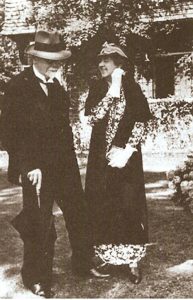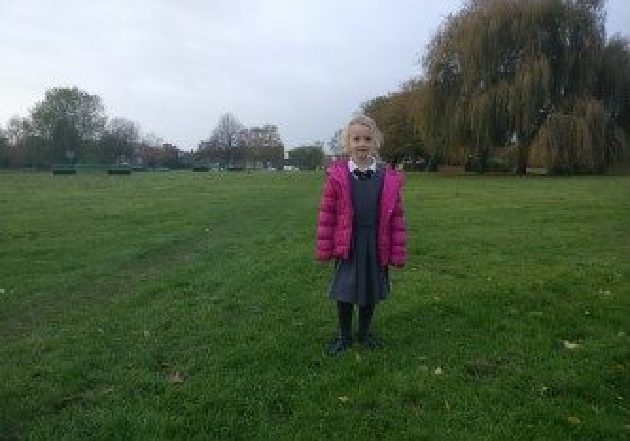
Rye residents may be familiar with Mason’s Field – a large open space alongside Udimore Road. How many of those same residents have ever wondered whether there was any story behind the name? I must admit that I hadn’t until a remark from Liz Butt, a music therapist, who founded the locally based Music Well charity. Liz said that Mason’s Field had been given to the people of Rye by a Mr Mason and that moreover he was her great-grandfather.
I was intrigued and felt that I wanted to know more. I read what I could on the subject which didn’t take long – there is very little available. However, I was able to get valuable information from Mrs Lindsay, Liz’s mother, who patiently supplied answers to some of my numerous questions.
I learnt that Mrs Lindsay’s grandfather, Thomas Alexander Mason, was born in 1859 in Southwark. He was brought up in comfortable circumstances, subsequently inheriting a successful family tobacco business. What made Thomas different to many another well-to-do businessman was that he devoted large sums of money to the public good, becoming a private benefactor on an impressive scale, but now little recognised because he was as modest as he was generous.
Mr Mason’s form of philanthropy was to buy pieces of open land which he then donated to the local community to be used for recreational purposes, but without his name being known. Mrs Lindsay shared an interesting family story of how one donation came about. She said that her grandfather, an enthusiast for the internal combustion engine, was motoring through High Halden near Tenterden one fine day when his chauffeur narrowly avoided a collision with a little girl playing in the road. This encounter led to the decision to buy some land for her and other children to play in safety well away from the road. The family treasures cuttings from two Sunday newspapers The People and the Sunday Graphic for September 23, 1934 which give a very brief description of this incident. It was unusual enough – with emphasis on the anonymity – to merit mention in the press.
The fields that Thomas Mason gave are in many locations including Hastings, Ninfield, Iden, Westfield, Beckley and Icklesham as well as the ones already mentioned and many more besides. But apart from this area there are sites further afield in Dorking, Glastonbury and Runnymede; most are in the south of England though there was a donation of land in Dent in Yorkshire given as the site of a new vicarage. Sometimes Thomas would take a day away from work, catch a train and get off at a random location. If on his wanderings he found a promising spot, he’d arrange to buy it and donate it.
Thomas’s wife shared her husband’s ethos. When an important wedding anniversary was looming Thomas offered his wife a diamond brooch to mark the event. His wife declined, saying that instead the money should be spent on a holiday home for poor children – hence the establishment of Pin Cottage, Reigate, offering fresh air and open space for children from the smoky and overcrowded East End of London. Mrs Mason was a talented amateur musician who delighted in holding musical evenings as well as being a poet of merit being published in Country Life among other popular periodicals of the era.
One plot of land was in Lowfield Heath. In 1926, when the land was donated, Lowfield Heath was a charming rural spot but subsequent decades saw the demolition of the village due to the expansion of Gatwick airport. The family agreed to sell the land, which had become rather valuable, and the money raised was used to establish the T Mason Trust.
The Tilling Green estate is reached via Mason Road. The council needed permission to put a road through the open space that Thomas had given to the people of Rye in order to access the land behind it. Eric Mason, Thomas’s son, agreed to this hence the name is preserved in Rye. Eric, following in his father’s footsteps, subsequently gave the playing field to the people of Iden, still well used and appreciated today.
Thomas Mason lived in Reigate for much of his life but in later years he and his wife moved to Wittersham and this is where he died in 1949. In the family’s possession is the parish magazine for St Paul’s Church for Seamen in Stepney for Easter 1958 reporting Mrs. Mason’s death in February. There were tributes from many who’d known and benefited from the generosity of Mr and Mrs Mason over more than 40 years. Some of those who’d travelled from Cannon Street to Reigate, excitedly clutching brown paper parcels of their worn and patched spare clothes, told how they’d experienced clean, comfortable, orderly Pin Cottage with plenty of good food, books to read and a huge toy chest before being sent home after two weeks with better clothing than they’d arrived with. Mrs Mason had been President of the Nursery at St Paul’s – a pioneering establishment, one of the first in the country to offer safe childcare for mothers forced to “work or starve” as the magazine put it.
Thomas Alexander Mason was a modest and retiring man who did his charitable work privately and anonymously, thus little is known about him, but his valuable legacy lives on and continues to benefit numerous communites, as he intended. Despite his reluctance to be named and lauded I hope that others would agree that he deserves lasting gratitude and to have his name and legacy remembered.
Mr Mason’s great-granddaughter, Liz Butt, is also enabling children to play by providing music therapy in Rye, thus continuing the tradition of philanthropy.
Photos: courtesy of the Mason family
Photos: courtesy of the Mason family




Thank you Diana for a very interesting article. As an Iden resident, I am only too aware of the generosity of the Mason family and as Diana says, we have our wonderful playing field thanks to the gift in 1934 by Eric Mason who came to live in Iden at Park Farm and bring up his family in the early days of the 20th century. One of the treasures I have is a book by Eileen Mason (Eric’s wife) of her memories of the early days at Park Farm and the love her family had for the area.
Iden has been very fortunate to have been endowed over the years with assets for community use by its philanthropic families. We would not have had our village hall, bowls club or Church Rooms without such generosity of spirit and of course we are so very grateful to Christopher Strangeways who saved our invaluable Village Stores from closure almost 20 years ago.
A few years ago I was able to discover in the Parish records another example of the Mason’s community spirit, even in small ways. In 1921, Iden like so many villages had lost many in the Great War and fund raised to purchase a War Memorial which cost £5. A villager also gave land to the Parish Council on which the Memorial would stand and paid all the legal fees involved. Unfortunately the Council was unable to pay its own legal costs of some £13. After 4 years of fund raising the Council was still £8 short and decided that as a last resort it would have to raise the Council rate by a half penny on residents who could ill afford such an additional financial burden.
Upon hearing this, Eric Mason sent the Council his personal cheque for £8.14.2 so that the costs could be finally settled.
A remarkable family indeed to whom we are all so indebted
What a delight to read a story like this on the Rye News website. Thank you Diana for researching so thoroughly and sharing such a heart warming piece of local history.
From now on, whenever I turn into Mason Road, I will think of Mr Thomas Mason and his selfless generosity.
What an interesting article from Diana & it filled a few gaps that even as a Ryer I had never been able to find the answer to. However it has opened another gap that perhaps Liz or other readers may be able to shed light on .. I had always known that Masons field had been a gift to the people of Rye but not that it was named after the benefactor or who he was . I did know that it was fairly well locked up legally , that it should not be sold on or used in any way not for the benefit of the people of Rye , in as much , that when the then Borough Council wanted to build Badger Gate sheltered housing project in the mid to late 60’s that they had to prove this project did benefit Rye before they could build . Diana”s article alludes to permission being required to put the access road ; Mason Road ”through’ the field to enable Tilling Green to be built . That infers that Tilling Green School (definitely ticked the box of being of benefit)was built on part of Mason’s field,perhaps Liz may have maps or documents relating to this or other historical types may know ? Be that so , it casts doubt on the County Councils aspirations to sell the Tilling Green school for development !!
Please can you answer as permission had to be granted to allow access to Tilling Green, does that mean the land in Tilling Green Community Centre is part of that gift?
Forgot to add it was lovely to read the story behind the gift. What a wonderful example of generosity.
Yes, thank you for raising the matter of the ‘gift’ of Mason’s Field for the benefit of the people of Rye and its implications should the old Tilling Green school be sold to developers. Since it was a gift it is hard to find records and deeds but any solicitor involved in the sale would be able to do so and then the procedure would be to seek the permission of living family members to proceed. This happened with a small piece of land near Gatwick airport which my great grandfather had donated. My mother (the nearest living relative) was consulted and negotiated a larger and nicer piece of land for the community in exchange.
If anyone has ideas about how to trace this gift more precisely I would be grateful.
Liz,
HMLR would be a good starting point in my opinion . if you can use something like https://www.nimbusmaps.co.uk to select and find the area of land it will return a registered title number with which you can telephone HMLR, but you would need some dates from them to go further . Depending on who you talk to at HMLR you may be able to find dates of transfers given to you . Hopefully armed with dates you can request documents from HMLR on relevant historic document forms. There is also a guide for costs on the HMLR website. Good luck 🙂 please share what you find.
What a fantastic read, Diana, Thank you for sharing this information of Mr Thomas Mason and his selfless generosity . Are there any documents in existence in regard to the properties he donated as ‘gifts’. I refer to the Village Green in Ore , Hastings which may have been one of such properties gifted.